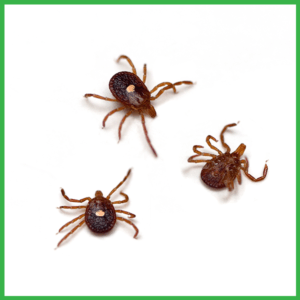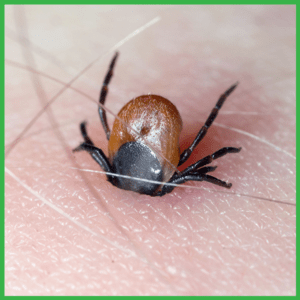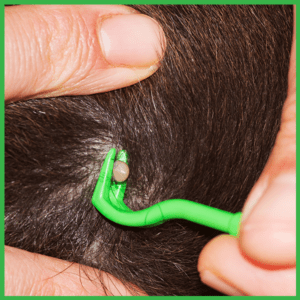Did you know that ticks can be a real danger to your pet’s life? While these little monsters are a nuisance for us humans, they can pose serious health risks for pets, especially if you don’t take care of the problem as soon as possible and ignore their existence.
As a responsible pet owner, it’s important to be aware of the dangers of ticks on dogs and cats and the steps needed to protect your furry companions.
Luckily, getting rid of ticks in pets is a simple process. Also, pest control services performed by SWF will help you protect your home to further reduce the risk of your dog or cat getting ticks.
Ticks: The Pet’s Main Enemy
Ticks, which are a type of ectoparasite, are commonly found on the surface of both dogs and cats.
The frequency and severity of tick infestations on pets may vary depending on several factors, such as your geographical location, the season, your pet’s behavior, and how and when you use tick control products.
It’s possible for pets to be exposed to ticks even if they spend most of their time indoors, and even short outdoor trips can result in tick infestations.
You can learn more about ticks here.
When Is “Ticks Season”?
As mentioned before, the frequency of tick activity on pets varies based on geographical location and season, so the “tick season” will differ depending on where you live.
Typically, summer is the peak tick season because ticks like warmer climates, so those who live in regions that are warm year-round are at higher risk throughout the year.
However, it’s important to note that tick prevention should not be neglected during cooler months. Protecting your pet from ticks should be a year-round priority, regardless of the season.
The Dangers of Ticks on Pets
Ticks use their mouthparts to attach themselves to your pet’s skin, and some ticks produce a sticky, glue-like substance that helps them remain attached. So, among the dangers of ticks on dogs, skin is noticeable redness and irritation in the areas of the skin where the ticks are attached.
The dangers of ticks on dogs don’t stop at just the skin; once attached, ticks will begin to feed on your pet’s blood, and they can consume enough blood to cause anemia. Certain female ticks can also produce toxins that cause a rare form of paralysis in pets.
Additionally, ticks can transmit various diseases to pets, dogs, and cats alike, with Lyme disease and Rocky Mountain spotted fever being the most well-known.
Lyme disease causes arthritis and swelling of your pet’s joints, leading to painful lameness, while Rocky Mountain spotted fever can cause fever, and lameness, among other symptoms. There are also other diseases transmitted by ticks that may be more prevalent in certain regions.
Now, you’re probably asking yourself self are tick-borne diseases in dogs curable? And the answer is that they are! However, it’s important to consult a veterinarian immediately once you notice any signs your dog has a tick or a tick-borne disease, so you can discuss disease treatment and prevention.
How Long Can A Tick Live on Cat or a Dog?
The length of time a tick can live on a cat or a cat can vary depending on several factors, including the species of tick, the age and health of the animal, and how promptly the tick is removed.
In general, ticks can feed on a cat for several days or up to a week before dropping off or being removed. During this time, they will engorge themselves with blood, which can cause the tick to swell in size.
Are Dog Ticks Dangerous to Humans?
Dog ticks are dangerous to humans because ticks that transmit diseases to pets can also transmit many of the same diseases to humans. For instance, diseases such as Lyme disease and Rocky Mountain spotted fever, which affect pets, can also be very serious in humans.
It’s important to note that humans do not contract tick-borne diseases from their pets. Both people and pets can acquire these diseases while spending time outdoors.
When ticks attach to a human, they will feed on their blood, which can cause a local reaction, such as a bump, scab, redness, or itching, which may not necessarily be a cause for concern.
However, if symptoms persist for more than 24 hours after tick removal, worsen, or are accompanied by other symptoms, it’s recommended to seek medical attention.
How to Prevent Ticks on Dogs and Cats? And How Can SWF Services Help You?
Now that you know the dangers of ticks on dogs and cats, let’s talk prevention.
To prevent ticks on dogs and cats, it’s important to take the following steps:
Vaccinate your pet
There are vaccines available for some tick-borne diseases, such as Lyme disease. Talk to your veterinarian to determine if these vaccines are recommended for your pet.
Inspect your pet
Regularly inspect your pet for ticks, especially after spending time outdoors. The faster you discover and remove a tick, the lesser the chance of transmitting any diseases it may be carrying.
Pay special attention to areas such as the ears, between the toes, and under the collar.
If you do find a tick, SWF recommends using a pair of pointed tweezers or a tick removal tool to promptly remove it. You need to grab the tick close to its head and gently pull it off.
Protect your home
Ticks may be closer than you think. If your yard is surrounded by a wooded area or if other pests are present, such as rodents, ticks could be living in your house.
So, it’s important to keep your yard well-maintained by trimming shrubs and trees and removing tall grass where ticks may reside.
When it comes to indoor protection, it’s recommended to vacuum regularly to remove any ticks that may have been brought inside on your pet. You may also want to consider using tick-repellent products; there’s a variety of indoor pest control sprays that are safe for pets.
By taking these steps, you can help protect your pet from tick-borne diseases and reduce the likelihood of ticks in your home.
Our professionals at SWF® can also help by inspecting your house. All you need to do is contact SWF to schedule an appointment. Don’t worry; pest control services are not dangerous or risky, and they are pet-friendly. You can learn more about the myths and facts about pest control services here.
SWF provides you with the best and safest pest control services in order to keep your home and your pets safe. Sign up using the form below and we’ll get in touch to see how we can help you.
[caldera_form id=”CF6039a67b301e7″]





